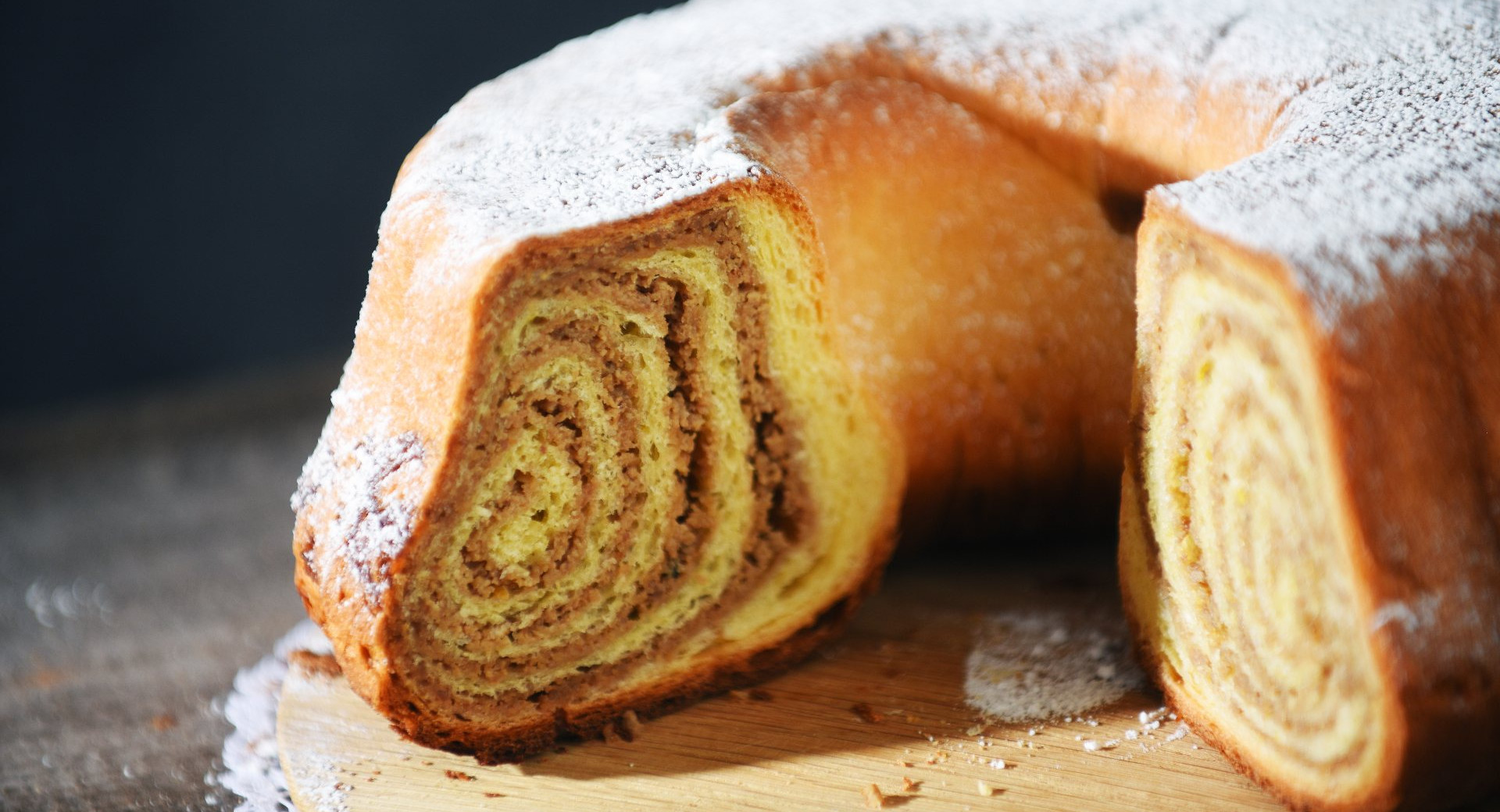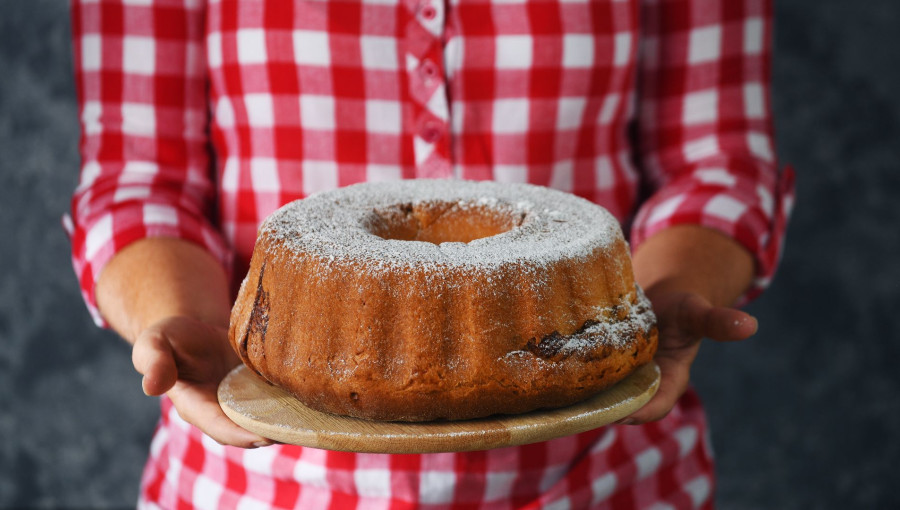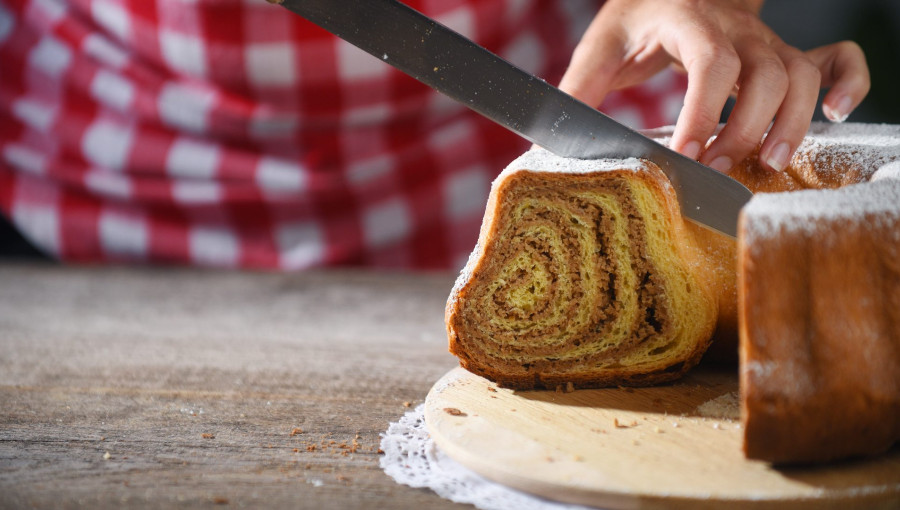Walnut Potica – Orehova potica
Potica, a rolled pastry stuffed with various fillings, is the queen of Slovenian holiday dishes.

For me holidays are all about spending time with family. On Christmas day, our table is heavily laden with holiday foods, with walnut potica always at its center. It is the time and place for a trip down memory lane.
When my mom was little, the kids in the family helped crack and grind walnuts but couldn’t resist eating them. To keep them from munching, my grandmother would encourage them to whistle to ensure that enough would be left for the potica.
The most typical type of potica is made with walnuts, but you can also find ones filled with raisins, poppy seeds, hazelnuts or tarragon.
More traditional Slovenian recipes you can find here.
How to make Potica?
You will need:
Dough
- 400 g (3 cups or 14 oz) soft pastry flour
- 200 g (1 ¼ cups or 7 oz) strong bread flour
- 42 g (1.5 oz) fresh yeast
- 100 g (½ cup or 3.5 oz) sugar
- 300 ml (1 ¼ cups or 10 fl oz) lukewarm milk
- 4 egg yolks
- 8 g (0.3 oz) vanilla sugar
- 1 tbsp rum
- ½ lemon, zested
- 5 g (0.2 oz) salt
- 50 g (1.8 oz) butter
Filling
- 300 g (11 oz) shelled walnuts
- 200 ml (¾ cup or 7 fl oz) milk
- 10 g (0.4 oz) vanilla sugar
- 120 g (5/8 cup or 4 oz) sugar
- 100 g (3.5 oz) butter
- ½ lemon, zested
- 2 tbsp rum
- 1 egg white and 15 g (0.5 oz) sugar for whipped egg white
You will also need
- Butter for buttering the mold/potičnik
- Strong bread flour to facilitate the dough rolling process
- Caster sugar and a thin wooden stick
- Potičnik 27 cm (10 inches) across

Place the eggs and yeast at room temperature at least half an hour before baking. Sift the flour into a mixing bowl (I prefer plastic bowls) to make it lighter and airier in texture. Mix gently to ensure both types of flour are well-integrated. Don’t use a bowl that is cold to the touch, as it will interfere with the quality of your leavened dough.
Yeast Mixture
Crush the yeast into a small bowl, add one teaspoon of sugar, 4 tablespoons of lukewarm milk and 1 tablespoon of sifted flour. Stir gently, cover the bowl with a dishcloth and allow the mixture to rise at room temperature until it doubles in size, about 10 to 15 minutes. In cold weather, set the mixture in a warm place to expedite fermentation.
Egg Yolk Mixture
Beat the egg yolks, sugar, vanilla sugar, rum, lemon zest and salt into a fluffy mixture before adding lukewarm milk to it.
Melt the butter and allow it to cool, so it’s not too hot when mixed with the flour.
Return to the bowl of sifted flour and form a depression in the center, then pour in the yeast mixture. Use a wooden spoon to slowly fold the flour from the edges into the yeast mixture.
Now add the egg yolk mixture and stir again before putting in the melted butter. Take 20 minutes to knead the ingredients until they form a soft, silky texture that doesn’t stick to your hands or the bowl. Add some strong bread flour, if necessary. Then form a loaf, cover it with plastic wrap and allow it to rise to twice its original size—about an hour to an hour and a half. For best leavening results, keep the room temperature above 25°C/77°F.

In the meantime, prepare the filling. First, grind the walnuts. Add vanilla and regular sugar to milk and bring everything to a boil for the sugar to dissolve. Then pour the milk over the ground walnuts. Melt the butter in a smaller pan and add it to the walnut mixture while still hot. Mix the walnut concoction well and allow it to cool before adding lemon zest and rum to it.
Beat the egg white with sugar and a pinch of salt until stiff and mix it carefully into the walnut mixture.
Prepare the work surface by laying a larger dishcloth over it, then sprinkle some strong bread flour evenly across it.
Place the dough on the dishcloth and roll it out to form a square that is 1 finger-width thick (1 cm/0.4 inches). Once rolled, the dough should measure 55x55 cm (21x21 inches) in size, which is a perfect fit for a 27 cm (10 inches) potičnik.
Spread the filling evenly to the edge of the stretched-out dough. Begin rolling up the dough from one side, gently pulling on the emerging tube to ensure the flat dough ahead is taut.
Use fingers while rolling up the dough to squeeze out trapped air, in order to prevent air bubbles from forming during baking. Pinch in the side edges as you go, to avoid filling-free bites. Continue until the dough is rolled up.
Butter the potičnik and use a kitchen cloth to determine the length of the dough to match the circumference of the potičnik.
Feel free to cut away the edges as necessary to ensure a proper fit. Place the dough into the potičnik. Use a thin wooden stick to poke holes through the dough to facilitate air expulsion, then cover it with a dishcloth and set it in a warm place for another one-hour leavening session. Preheat the convection oven to 180°C/350°F. Perforate the dough again, put it in the oven and bake for one hour.
If the crust turns yellow before the end of baking, cover the potica with baking paper, otherwise, keep the oven closed the entire time.
When baked (check by inserting a knife blade into the dough—it’s done when the blade is clean), take the mold out of the oven and immediately flip it over so it slides out. Allow it to cool, preferably on a wooden surface, then sprinkle caster sugar over it.

